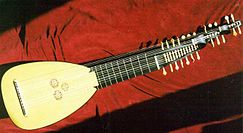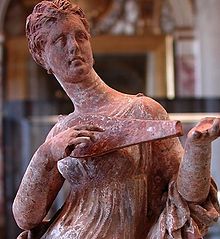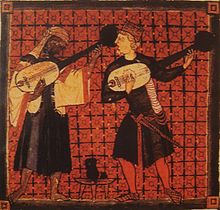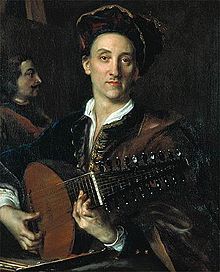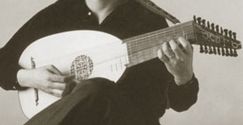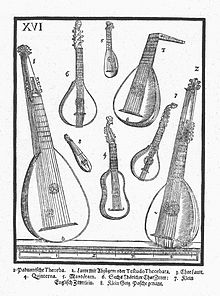- Lute
-
Lute 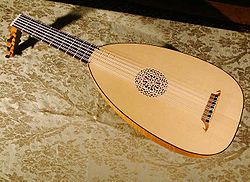
A renaissance-era lutestrings Classification - Necked bowl lutes
- String instruments
Hornbostel–Sachs classification 321.321-5
(Composite chordophone sounded by the bare fingers)Developed Classical antiquity (early lutes)
Middle Ages (modern lutes)Related instruments Lute can refer generally to any plucked string instrument with a neck (either fretted or unfretted) and a deep round back, or more specifically to an instrument from the family of European lutes.
The European lute and the modern Near-Eastern oud both descend from a common ancestor via diverging evolutionary paths. The lute is used in a great variety of instrumental music from the Medieval to the late Baroque eras and was probably the most important instrument for secular music in the Renaissance. It is also an accompanying instrument, especially in vocal works, often realizing a basso continuo or playing a written-out accompaniment.
The player of a lute is called a lutenist, lutanist or lutist, and a maker of lutes (or any string instrument) is referred to as a luthier.
Contents
Etymology
The words "lute" and "oud" derive from Arabic al‘ud (العود; literally "the wood").[1] Recent research by Eckhard Neubauer suggests ‘ud may in turn be an Arabized version of the Persian name rud, which meant "string", "stringed instrument", or "lute".[2] It has equally been suggested the "wood" in the name may have distinguished the instrument by its wooden soundboard from skin-faced predecessors.[3] Gianfranco Lotti suggests the "wood" appellation originally carried derogatory connotations because of proscriptions of all instrumental music in early Islam.
Construction
Soundboard
Lutes are made almost entirely of wood. The soundboard is a teardrop-shaped thin flat plate of resonant wood (typically spruce). In all lutes the soundboard has a single (sometimes triple) decorated sound hole under the strings called the rose. The sound hole is not open, but rather covered with a grille in the form of an intertwining vine or a decorative knot, carved directly out of the wood of the soundboard.
Back
The back or the shell is assembled from thin strips of hardwood (maple, cherry, ebony, rosewood, gran, wood and/or other tonewoods) called ribs, joined (with glue) edge to edge to form a deep rounded body for the instrument. There are braces inside on the soundboard to give it strength; see the photo among the external links below.
Neck
The neck is made of light wood, with a veneer of hardwood (usually ebony) to provide durability for the fretboard beneath the strings. Unlike most modern stringed instruments, the lute's fretboard is mounted flush with the top. The pegbox for lutes before the Baroque era was angled back from the neck at almost 90° (see image), presumably to help hold the low-tension strings firmly against the nut, which is not traditionally glued in place, but is held in place by string pressure only. The tuning pegs are simple pegs of hardwood, somewhat tapered, that are held in place by friction in holes drilled through the pegbox. As with other instruments using friction pegs, the choice of wood used to make pegs is crucial. As the wood suffers dimensional changes through age and loss of humidity, it must as closely as possible retain a circular cross-section in order to function properly, as there are no gears or other mechanical aids for tuning the instrument. Often pegs were made from suitable fruitwoods such as European pearwood, or equally dimensionally stable analogues. Matheson, ca 1720, stated "if a lute-player has lived eighty years, he has surely spent sixty years tuning."
Belly
The geometry of the lute belly is relatively complex, involving a system of barring in which braces are placed perpendicular to the strings at specific lengths along the overall length of the belly, the ends of which are angled quite precisely to abut the ribs on either side for structural reasons. Robert Lundberg, in his book "Historical Lute Construction", suggests ancient builders placed bars according to whole-number ratios of the scale length and belly length. He further suggests the inward bend of the soundboard (the "belly scoop") is a deliberate adaptation by ancient builders to afford the lutenist's right hand more space between the strings and soundboard. The belly thickness is somewhat variable, but hovers between 1.5 and 2 millimeters in general. Some luthiers tune the belly as they build, removing mass and adapting bracing to ensure proper sonic results. The lute belly is almost never finished, but in some cases the luthier may size the top with a very thin coat of shellac or glair in order to help keep it clean. The belly is joined directly to the rib, without a lining glued to the sides, and a cap and counter cap are glued to the inside and outside of the bottom end of the bowl to provide rigidity and increased gluing surface.
After joining the top to the sides, a half-binding is usually installed around the edge of the belly. The half-binding is approximately half the thickness of the belly and is usually made of a contrasting color wood. The rebate for the half-binding must be extremely precise to avoid compromising structural integrity.
Bridge
The bridge, sometimes made of a fruitwood, is attached to the soundboard typically at 1/5 to 1/7 the belly length. It does not have a separate saddle but has holes bored into it to which the strings attach directly. The bridge is made so that it tapers in height and length, with the small end holding the trebles and the higher and wider end carrying the basses. Bridges are often colored black with carbon black in a binder, often shellac and often have inscribed decoration. The scrolls or other decoration on the ends of lute bridges are integral to the bridge, and are not added afterwards as on some Renaissance guitars (cf Joachim Tielke's guitars).
Frets
The frets are made of loops of gut tied around the neck. They fray with use, and must be replaced from time to time. A few additional partial frets of wood are usually glued to the body of the instrument, to allow stopping the highest-pitched courses up to a full octave higher than the open string, though these are anachronistic and do not appear on original instruments. Given the choice between nylon and gut, many luthiers prefer to use gut, as it conforms more readily to the sharp angle at the edge of the fingerboard.
Strings
Strings were historically made of animal gut, usually from the small intestine of sheep (sometimes in combination with metal) and are still made of gut or a synthetic substitute, with metal windings on the lower-pitched strings. Modern manufacturers make both gut and nylon strings, and both are in common use. Gut is more authentic for playing period pieces, though unfortunately it is also more susceptible to irregularity and pitch instability due to changes in humidity. Nylon offers greater tuning stability, but is seen as anachronistic by purists, as its timbre differs from the sound of earlier gut strings. Such concerns are moot when more recent compositions for the lute are performed.
Of note are the "catlines" used as basses on historical instruments. Catlines are several gut strings wound together and soaked in heavy metal solutions which increase the mass of the strings. Catlines can be quite large in diameter by comparison with wound nylon strings for the same pitch. They produce a bass which differs somewhat in timbre from nylon basses.
The lute's strings are arranged in courses, of two strings each, though the highest-pitched course usually consists of only a single string, called the chanterelle. In later Baroque lutes two upper courses are single. The courses are numbered sequentially, counting from the highest pitched, so that the chanterelle is the first course, the next pair of strings is the second course, etc. Thus an 8-course Renaissance lute will usually have 15 strings, and a 13-course Baroque lute will have 24.
The courses are tuned in unison for high and intermediate pitches, but for lower pitches one of the two strings is tuned an octave higher. (The course at which this split starts changed over the history of the lute.) The two strings of a course are virtually always stopped and plucked together, as if a single string, but in extremely rare cases a piece calls for the two strings of a course to be stopped and/or plucked separately. The tuning of a lute is a somewhat complicated issue, and is described in a separate section of its own below. The result of the lute's design is an instrument extremely light for its size.
History and evolution of the lute
The origins of the lute are obscure, and organologists disagree about the very definition of a lute. The highly influential organologist Curt Sachs distinguished between the "long-necked lute" (Langhalslaute) and the short-necked variety: both referred to chordophones with a neck as distinguished from harps and psalteries. Smith and others argue the long-necked variety should not be called lute at all because it existed for at least a millennium before the appearance of the short-necked instrument that eventually evolved into what is now known as the lute. It also was never called a lute before the 20th century.
Source of our knowledge about these instruments is since the ancient Greek Mantineia marble (4th century BC), now exhibited at National Archaeological Museum of Athens, depicting the mythical contest between Apollo and Marsyas, where ancient Greek Pandura is being played by a muse seated on a rock[4]documenting that lutes have been first present in ancient Greece, since the Akkadian era.[5]
Various types of necked chordophones were in use in ancient Greek, Egyptian (in the Middle Kingdom), Hittite, Roman, Bulgar, Turkic, Indian, Chinese, Armenian/Cilician cultures. The Lute developed its familiar forms as Barbat in Persia, Armenia, and Byzantium beginning in the early 7th century. These instruments often had bodies covered with animal skin, and it is unknown exactly when it became replaced with a wooden soundboard.
As early as the 6th century, the Bulgars brought the short-necked variety of the instrument called Komuz to the Balkans, and in the 9th century, Moors brought the Oud to Spain. The long-necked Pandura had previously been a quite common variety of the lute in the Mediterranean. The quitra did not become extinct, however, but continued its evolution. Besides the still surviving Kuitra of Algiers and Morocco, its descendants include the Chitarra Italiana, Chitarrone and Colascione.
In about the year 1500 many Spanish, Catalan and Portuguese lutenists adopted vihuela de mano, a viol-shaped instrument tuned like the lute, but both instruments continued in coexistence. This instrument also found its way to parts of Italy that were under Spanish domination (especially Sicily and the papal states under the Borgia pope Alexander VI who brought many Catalan musicians to Italy), where it was known as the viola da mano.
Another important point of transfer of the lute from Arabian to European culture might have been in Sicily, where it was brought either by Byzantine or later by Saracen musicians. There were singer-lutenists at the court in Palermo following the Norman conquest of the island, and the lute is depicted extensively in the ceiling paintings in the Palermo’s royal Cappella Palatina, dedicated by the Norman King Roger II in 1140. By the 14th century, lutes had disseminated throughout Italy. Probably due to the cultural influence of the Hohenstaufen kings and emperor, based in Palermo, the lute had also made significant inroads into the German-speaking lands by the 14th century.
Medieval lutes were 4- or 5-course instruments, plucked using a quill as a plectrum. There were several sizes, and by the end of the Renaissance, seven different sizes (up to the great octave bass) are documented. Song accompaniment was probably the lute's primary function in the Middle Ages, but very little music securely attributable to the lute survives from the era before 1500. Medieval and early-Renaissance song accompaniments were probably mostly improvised, hence the lack of written records.
In the last few decades of the 15th century, in order to play Renaissance polyphony on a single instrument, lutenists gradually abandoned the quill in favor of plucking the instrument with the fingertips. The number of courses grew to six and beyond. The lute was the premier solo instrument of the 16th century, but continued to be used to accompany singers as well.
By the end of the Renaissance the number of courses had grown to ten, and during the Baroque era the number continued to grow until it reached 14 (and occasionally as many as 19). These instruments, with up to 26-35 strings, required innovations in the structure of the lute. At the end of the lute's evolution the archlute, theorbo and torban had long extensions attached to the main tuning head in order to provide a greater resonating length for the bass strings, and since human fingers are not long enough to stop strings across a neck wide enough to hold 14 courses, the bass strings were placed outside the fretboard, and were played "open", i.e. without fretting/stopping them with the left hand.
Over the course of the Baroque era the lute was increasingly relegated to the continuo accompaniment, and was eventually superseded in that role by keyboard instruments. The lute almost fell out of use after 1800. Some sorts of lute were still used for some time in Germany, Sweden, Ukraine.
Lute in the modern world
The lute enjoyed a revival with the awakening of interest in historical music around 1900 and throughout the century. That revival was further boosted by the early music movement in the twentieth century. Important pioneers in lute revival were Julian Bream, Hans Neemann, Walter Gerwig, Suzanne Bloch and Diana Poulton. Lute performances are now not uncommon; there are many professional lutenists, especially in Europe where the most employment is to be found, and new compositions for the instrument are being produced by composers.
During the early days of the early music movement, many lutes were constructed by available luthiers, whose specialty was often classical guitars. Such lutes were heavily built with construction similar to classical guitars, with fan bracing, heavy tops, fixed frets, and lined sides, all of which are anachronistic to historical lutes. As lutherie scholarship increased, makers began constructing instruments based on historical models, which have proven on the whole to be far lighter and more responsive instruments.
Lutes built at present are invariably replicas or near copies of those surviving historical instruments that are to be found in museums or private collections. They are exclusively custom-built or must be bought second hand in a very limited market. As a result, lutes are generally more expensive than mass-produced modern instruments such as the guitar, though not nearly as expensive as the violin. Unlike in the past there are many types of lutes encountered today: 5-course medieval lutes, renaissance lutes of 6 to 10 courses in many pitches for solo and ensemble performance of Renaissance works, the archlute of Baroque works, 11-course lutes in d-minor tuning for 17th century French, German and Czech music, 13/14-course d-minor tuned German Baroque Lutes for later High Baroque and Classical music, theorbo for basso continuo parts in Baroque ensembles, gallichons/mandoras, bandoras, orpharions and others. Lutenistic practice has reached considerable heights in recent years, thanks to a growing number of world-class lutenists: Robert Barto, Eduardo Egüez, Edin Karamazov, Nigel North, Christopher Wilson, Luca Pianca, Pascal Monteilhet, Lex van Sante, Ariel Abramovich, Evangelina Mascardi, Luciano Contini, Hopkinson Smith, Yasunori Imamura, Paul O'Dette, Jozef van Wissem et alii. Singer-songwriter Sting has also played lute and archlute, in and out of his collaborations with Edin Karamazov, and Jan Akkerman released two albums of lute music in the 1970s while he was a guitarist in the Dutch rock band Focus. Lutenist/ Composer Jozef van Wissem composed lute music and vocals for the Sims Medieval video game.
Lutes of several regional types are also common in Greece: laouto, and outi.
Lute repertoire
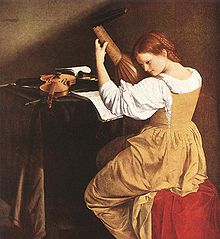 Orazio Gentileschi's young lutenist, painted ca 1626, plays a 10-course lute, typical of the time from around 1600 AD through the 1630s. Music stands appear very rarely in paintings of the period—the music is most commonly laid flat on a table, as seen here.
Orazio Gentileschi's young lutenist, painted ca 1626, plays a 10-course lute, typical of the time from around 1600 AD through the 1630s. Music stands appear very rarely in paintings of the period—the music is most commonly laid flat on a table, as seen here.
Although lutes were in widespread use in Europe at least since the 13th century, and documents mention numerous early performers and composers, the earliest surviving music for the instrument dates from the late 15th century. Lute music flourished during the 16th and 17th centuries: numerous composers published collections of their music, and modern scholars have uncovered a vast number of manuscripts from the era—however, much of the music is still lost. In the second half of the 17th century lutes, vihuelas and similar instruments started losing popularity, and almost no music had been written for the instrument after 1750. The interest in lute music was revived only in the second half of the 20th century.
Improvisation was apparently a highly important aspect of lute performance, and so much of the repertoire was probably never written down. Furthermore, it was only around 1500 that lute players started the transition from plectrum technique to that of the right hand: the latter allowed for complex polyphony, for which notation had to be developed. During the next hundred years three schools of tablature notation developed gradually: Italian (also employed in Spain), German and French. Only the latter survived into the late 17th century. The earliest known tablatures are designed for a six-stringed instrument, although evidence of earlier four- and five-stringed lutes exists.[6] Tablature notation depends on the actual instrument for which the music is written, and to read it, it is necessary to know the tuning, the number of strings, etc. of the instrument.
Renaissance and Baroque forms of lute music are more or less similar to those of keyboard music of the periods. Intabulations of vocal works were very common, as well as various dances, some of which disappeared during the 17th century, such as the piva and the saltarello. The advent of polyphony brought about fantasias: complex, intricate pieces with much use of imitative counterpoint. The improvisatory element, present to some degree in most lute pieces, is particularly evident in the early ricercares (not imitative as their later namesakes, but completely free), as well as in numerous preludial forms: preludes, tastar de corde ("testing the strings"), etc. During the 17th century keyboard and lute music went hand in hand, and by 1700 lutenists were writing suites of dances quite akin to those of keyboard composers. The lute was also used throughout its history as an ensemble instrument, most frequently in songs for voice and lute; these were particularly popular in Italy (see frottola) and England.
The earliest surviving lute music is Italian, from a late 15th century manuscript. The early 16th century saw Petrucci's publications of lute music by Francesco Spinacino (fl. 1507) and Joan Ambrosio Dalza (fl. 1508); together with the so-called Capirola Lutebook, these represent the earliest stage of written lute music in Italy. The leader of the next generation of Italian lutenists, Francesco Canova da Milano (1497–1543), is now acknowledged as one of the most famous lute composers in history. The bigger part of his output consists of pieces called fantasias or ricercares, in which he makes extensive use of imitation and sequence, expanding the scope of lute polyphony. The second half of the century saw no composers equal in stature, but in the early 17th century Johannes Hieronymus Kapsberger (c.1580–1651) and Alessandro Piccinini (1566–1638) revolutionized the instrument's technique and Kapsberger, possibly, influenced the keyboard music of Frescobaldi.
French written lute music began, as far as we know, with Pierre Attaingnant's (c.1494–c.1551) prints, which comprised preludes, dances and intabulations. Particularly important was the Italian composer Albert de Rippe (1500–1551), who worked in France and composed polyphonic fantasias of considerable complexity. His work was published posthumously by his pupil, Guillaume de Morlaye (born c.1510), who, however, did not pick up the complex polyphony of de Rippe. French lute music declined during the second part of the 16th century; however, various changes to the instrument (the increase of diapason strings, new tunings, etc.) prompted an important change in style that led, during the early Baroque, to the celebrated style brisé: broken, arpeggiated textures that influenced Johann Jakob Froberger's suites. The French Baroque school is exemplified by composers such as Ennemond Gaultier (1575–1651), Denis Gaultier (1597/1603–1672), François Dufaut (before 1604–before 1672) and many others. The last stage of French lute music is exemplified by Robert de Visée (c.1655–1732/3), whose suites exploit the instrument's possibilities to the fullest.
The history of German written lute music started with Arnolt Schlick (c.1460–after 1521), who published in 1513 a collection of pieces that included 14 voice and lute songs and three solo lute pieces, alongside organ works. He was not, however, the first important German lutenist, because contemporaries credited Conrad Paumann (c. 1410–1473) with the invention of German lute tablature. However, this claim has yet to be proven, and no lute works by Paumann survive. After Schlick, a string of composers developed German lute music: Hans Judenkünig (c.1445–50–1526), the Neusidler family (particularly Hans Neusidler (c.1508/9–1563)) and others. During the second half of the 16th century, German tablature and German repertoire were gradually replaced by Italian and French tablature and international repertoire, respectively, and the Thirty Years War (1618–48) effectively stopped publications for half a century. German lute music was revived much later by composers such as Esaias Reusner (fl. 1670), however, a distinctly German style came only after 1700 in the works of Silvius Leopold Weiss (1686–1750), one of the greatest lute composers, some of whose works were transcribed for keyboard by none other than Johann Sebastian Bach (1685–1750), who composed a few pieces for the lute himself (although it is unclear whether they were really intended for the lute, rather than another plucked string instrument or the lautenwerk).
Of other European countries, particularly important are England and Spain. English written lute music only began around 1540, however, the country produced numerous lutenists, of which John Dowland (1563–1626) is perhaps the most famous. His influence spread very far: variations on his themes were written by keyboard composers in Germany decades after his death. Dowland's predecessors and colleagues, such as Anthony Holborne (c. 1545–1602) and Daniel Bacheler (1572–1619), were less known. Spanish composers wrote mostly for the vihuela; their main genres were polyphonic fantasias and differencias (variations). Luys Milan (c.1500–after 1560) and Luys de Narváez (fl. 1526–49) were particularly important for their contributions to the development of lute polyphony in Spain. Finally, perhaps the most influential European lute composer was the Hungarian Bálint Bakfark (c.1526–30–1576), whose contrapuntal fantasias were much more difficult and tighter than those of his Western European contemporaries.
Lute revival and composers
The revival of lute-playing in the 20th century revitalized the interest of composers in the instruments of the lute family. One of the first such composers was Johann Nepomuk David in Germany. Composer Vladimir Vavilov was a pioneer of the lute revival in the USSR, also the author of numerous musical hoaxes. Sandor Kallos, Stefan Lundgren, Toyohiko Satoh applied modernist idiom to the lute, Elena Kats-Chernin, Jozef van Wissem and Alexandre Danilevsky minimalist and post-minimalist idiom, Robert Allworth serial composition, composing the first modern Concerto for the 11 course lute in his romantic 12-tone style, Roman Turovsky-Savchuk, Paulo Galvão, Robert MacKillop and Maxym Zvonaryov historicist idiom, and Ronn McFarlane New Age.
Tuning conventions
Lutes were made in a large variety of sizes, with varying numbers of strings/courses, and with no permanent standard for tuning. However, the following seems to have been generally true of the Renaissance lute: A 6-course Renaissance tenor lute would be tuned to the same intervals as a tenor viol, with intervals of a perfect fourth between all the courses except the 3rd and 4th, which differed only by a major third. The tenor lute was usually tuned nominally "in g" (there was no pitch standard before the 20th century), named after the pitch of the highest course, yielding the pattern [(G'G) (Cc) (FF) (AA) (dd) (g)] from the lowest course to the highest. (Much renaissance lute music can be played on a guitar by tuning the guitar's third string down by a half tone.)
For lutes with more than six courses the extra courses would be added on the low end. Due to the large number of strings lutes have very wide necks, and it is difficult to stop strings beyond the sixth course, so additional courses were usually tuned to pitches useful as bass notes rather than continuing the regular pattern of fourths, and these lower courses are most often played without stopping. Thus an 8-course tenor Renaissance lute would be tuned to [(D'D) (F'F) (G'G) (Cc) (FF) (AA) (dd) (g)], and a 10-course to [(C'C) (D'D) (E♭'E♭) (F'F) (G'G) (Cc) (FF) (AA) (dd) (g)].
However, none of these patterns were de rigueur, and a modern lutenist will occasionally be seen to retune one or more courses between performance pieces. Manuscripts bear instructions for the player, e.g. 7e choeur en fa = "seventh course in fa" (= F in the standard C scale).
The first part of the seventeenth century was a period of considerable diversity in the tuning of the lute, particularly in France. However, by around 1670 the scheme known today as the "Baroque"[1] or "d-minor" tuning became the norm, at least in France and in northern and central Europe. In this case the first six courses outline a d-minor triad, and an additional five to seven courses are tuned generally scalewise below them. Thus the 13-course lute played by [2] Weiss would have been tuned [(A"A') (B"B') (C'C) (D'D) (E'E) (F'F) (G'G) (A'A') (DD) (FF) (AA) (d) (f)], or with sharps or flats on the lower 7 courses appropriate to the key of the piece.
Modern lutenists tune to a variety of pitch standards, ranging from A = 392 to 470 Hz, depending on the type of instrument they are playing, the repertory, the pitch of other instruments in an ensemble and other performing expediencies. No attempt at a universal pitch standard existed during the period of the lute's historical popularity. The standards varied over time and from place to place.
Quotations
The art of playing the lute formed a major part of instrumental music-making in the Renaissance before keyboard instruments assumed central significance. It was a refined, soft and at the same time colorful art, in sharp contrast to the agitated times in which it was practiced.This style knows nothing of the otherwise usual requirements and prohibitions of voice-leading; it can only be understood in relation to the fingering technique; it frequently applies the sound of open strings and in no way avoids the otherwise so despised parallel 5ths and octaves or unisons. The dissonances and other conflicting sounds which appear so often ... strike me as exciting and revealing.See also
Instruments
European Lutes:
- String instruments
- Early music
- Medieval music
- Renaissance music
- Baroque music
- Classical Music
- Greek Music
African Lutes:
-
- Gonje
- Xalam
Asian Lutes:
Composers of lute music
- Category:Composers for lute
- List of composers for lute
Lute players
- Category: Lutenists
Lute makers
- Joachim Tielke
- Cezar Mateus
- Andrew Rutherford
- Nico van der Waals
- Michael Lowe
- Stephen Murphy
Notes
- ^ "Etymology Online". http://www.etymonline.com/index.php?search=lute. Retrieved July 12, 2010.
- ^ Douglas Alton Smith. A History of the Lute from Antiquity to the Renaissance. p. 9. Lute Society of America (LSA), 2002. ISBN 0-9714071-0-X.
- ^ During, Jean. "'Barbat'". Encyclopedia Iranica. http://www.iranica.com/articles/barbat. Retrieved 17 April 2011.
- ^ 4th century BC, the trichord, pandouris on a Greek marble in ancient Greece
- ^ Pandura, the first appearence in Greece.
- ^ Apel 1949, 54.
- ^ a b From the liner notes to the Wergo edition of Orff's Kleines Konzert, with English translations by John Patrick Thomas.
References
- The Lute in Europe by Andreas Schlegel, published by The Lute Corner (2006). ISBN 978-3-9523232-0-5
- A History of the Lute from Antiquity to the Renaissance by Douglas Alton Smith, published by the Lute Society of America (2002). ISBN 0-9714071-0-X ISBN 978-0-9714071-0-7
- The Lute in Britain: A History of the Instrument and its Music by Matthew Spring, published by Oxford University Press (2001).
- Historical Lute Construction by Robert Lundberg, published by the Guild of American Luthiers (2002).
- La musique de luth en France au XVIe siècle by Jean-Michel Vaccaro (1981).
- Articles in Journal of the Lute Society of America (1968–), The Lute (1958–), and other journals published by the various national lute societies.
- Eckhard Neubauer, "Der Bau der Laute und ihre Besaitung nach arabischen, persischen und türkischen Quellen des 9. bis 15. Jahrhunderts", Zeitschrift für Geschichte der arabisch-islamischen Wissenschaften, vol. 8 (1993): 279–378.
External links
Lute societies
- The Lute Society (UK)
- The Lute Society of America
- The German Lute Society
- The French Lute Society
- The Lute Society of Japan
- The Belgian Lute Society
- The Lute and Early Guitar Society (Founded by Toyohiko Satoh)
Lute music online and other useful resources
- reneszanszlant.lap.hu collection of many useful links: luthiers/lute makers, lute players, tablatures, etc. (in English and Hungarian)
- ABC Classic FM presents: Lute Project videos Watch Tommie Andersson play the theorbo, 7-course & 10-course lutes.
- Wayne Cripps' lute pages
- The Lute Lieder Site, library of songs and lieder with baroque lute accompaniment.
- The Ukrainian Lute Page Torban, a Ukrainian variety of lute/theorbo.
- Lute History by István Kónya
- Joachim Tielke The website for the great Hamburg lutemaker Joachim Tielke
- Musick's Handmade Facsimiles/Scans (Dowland, etc.) and pdfs - by Alain Veylit
- Sarge Gerbode's Lute Page 3000+ lute solo pieces by 140 composers in midi, PDF, TAB, and Fronimo formats
- Contemporary and Modern Lute Music Modern (post 1815) and Contemporary Lute Music. A list of modern lute music written after 1815
Photos of historic lutes
- Photos of historic lutes at the Museum Cité de la Musique in Paris
-
- Instruments et oeuvres d'art – search-phrase: Mot-clé(s) : luth
- Facteurs d'instruments – search-phrase: Instrument fabriqué : luth
- Photothèque – search-phrase: Instrument de musique, ville ou pays : luth
Articles and resources
- Pioneers of the Lute Revivial by Jo Van Herck (Belgian Lute Academy)
- Original: Over de pioniers van de luitrevival; Luthinerie / Geluit no. 15 (september 2001) and no. 16 (december 2001)
Categories:- Composite chordophones
- Necked bowl lutes
- Lutes
- Early musical instruments
- Baroque instruments
- Arabic words and phrases
Wikimedia Foundation. 2010.

